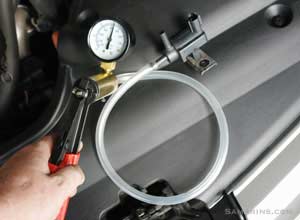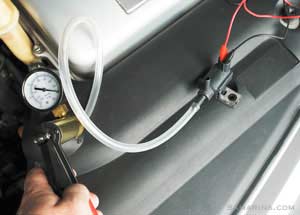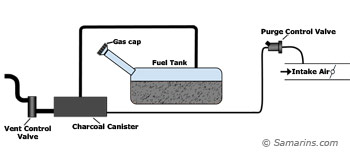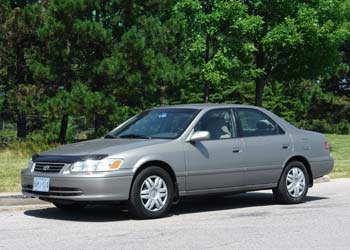P0441 Evaporative Emission Control System Incorrect Purge Flow
The code P0441 means that the Evaporative control system purge flow is incorrect. The Evaporative control system (EVAP) prevents gasoline vapors from the fuel tank from escaping into the atmosphere. The EVAP system catches and stores gasoline vapors in a small box installed near the fuel tank called charcoal canister. When you drive and certain conditions (speed, engine temperature, etc.) are met, fuel vapors are gradually purged from the charcoal canister and burned inside your engine. The code P0441 means that the purge flow is lower or higher than it should be. The purge flow is controlled by the purge valve (purge solenoid).Symptoms:
Other than the Check Engine light, there might be no driveability symptoms or the engine may surge or run a little rough at idle.What can cause the code P0441:
- bad purge valve- clogged or disconnected purge line
- vacuum leak near the purge line /engine intake connection
- bad vapor pressure sensor
- damaged or cracked charcoal canister
- faulty leak detection pump (LDP)
- bad NVLD unit (Chrysler)
- sticking or faulty vent valve
- cracked or clogged EVAP VSV vacuum hoses (Toyota)
- bad EVAP VSV valve (Toyota)
- improperly routed vacuum hoses
- open or short in the purge valve control wiring
- rusted filler neck (rust belt states)
How the code p0441 is diagnosed:
Without a scan-tool: The first part is to check visually for obvious problems: if the gas cap closed properly, there is no cracks or other damage on the charcoal canister and all vacuum hoses related to the EVAP system are properly connected. If no obvious problem is found, the purge valve needs to be tested next.The purge valve is normally closed. It opens when voltage is applied to its terminals. The purge valve is typically tested with a hand-held vacuum pump. It should hold the vacuum when closed (no voltage) and open fully when voltage is applied; see below. Sometimes the purge valve may be sticking intermittently, but work properly when tested. If there is any suspicion, the purge valve must be replaced; it's not very expensive.
If there are other codes, such as P0446 or P0442, they need to be checked out first, as the P0441 can be triggered by the same fault.
With a scan tool: The manufacturer-specific scan tools have capability to run the test of the whole EVAP system. With a generic scan tool, the purge valve must be activated, and the EVAP system pressure monitored.
Common problems causing the code P0441
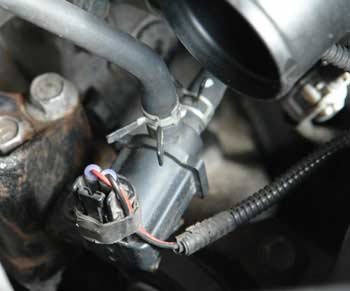 Purge Valve (Solenoid)
Purge Valve (Solenoid)Often when a charcoal canister starts failing, the charcoal pellets get drawn into the purge line and clog up the purge valve or the purge lines. If a lot of charcoal pellets are found stuck inside the purge valve, the charcoal canister might also need to be replaced.
In many late 90-s, early 00's Toyota and Lexus vehicles, there is an EVAP VSV valve and vacuum hoses at the charcoal canister that need to be tested. Often, it's the VSV that goes bad, or one of the vacuum hoses gets clogged up with charcoal pellets from the canister.
Unfortunately, Toyota sells the EVAP VSV valves as one unit with the canister, which is quite expensive, but we found the VSV valves available separately on Ebay and Amazon. Either way, all vacuum hoses connected to the EVAP VSV valves must be replaced and vacuum metal lines must be tested for blockage and cleaned.
The Toyota technical service bulletin (TSB) dated 2003, also mentions the inoperative Canister Closed Valve Vacuum Switching Valve (CCV VSV) as the possible reason for the codes P0441 and P0446. The CCV VSV must be tested and replaced with an updated part if inoperative.
In 2002-2007 Dodge and Chrysler vehicles, the NVLD unit is fairly common to fail and causes the code P0441.
How to check the EVAP purge valve (solenoid)
The purge valve is typically electrically powered. You can find the procedure to test a purge valve in the service manual. We included a list of websites offering paid access to service manuals for different cars at the bottom of this article. In most cars, the purge is fully closed without voltage.In this Toyota, for example, the purge valve is tested with a vacuum gauge (in the photo). The vacuum pump with the gauge is connected to one side of the valve. When the vacuum is applied, the purge valve should hold the vacuum and not leak. If the vacuum drops (the gauge needle moves), the purge valve is leaking and must be replaced. When the battery voltage is applied, there should be an audible click and the purge valve should be fully open. This purge valve is OK. Read more about the purge valve >.
How the EVAP system purge works
The Evaporative System (EVAP) catches the gasoline vapors escaping from the gas tank and stores them in the charcoal canister. When the engine is running and other conditions allow, the vapors are purged into the engine and burned along with the air/fuel mixture.The engine computer controls the amount of purge flow by gradually opening or closing the purge valve. The actual amount of purge flow is typically monitored by the EVAP pressure sensor, as well as a number of other sensors. If the actual amount of the purge flow is different from what is expected, the engine computer determines a fault and stores the code P0441 Evaporative Emission Control System Incorrect Purge Flow. This could mean, for example, that there is a purge flow when the purge valve is supposed to be fully closed or there is no or limited flow when the purge valve is open.
